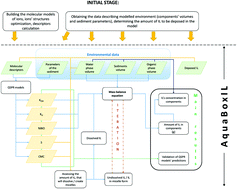AquaBoxIL – a computational tool for determining the environmental distribution profile of ionic liquids†
Abstract
We present the AquaBoxIL tool for comparing ionic liquids (ILs) in terms of their theoretical Environmental Distribution Profile (EDP). We define the EDP as the most probable scenario of an IL's distribution among various environmental compartments, in the case of its deposition in the environment. In the AquaBoxIL tool, these compartments are water, sediment and organic matter (representing biota). The calculations are performed with the consideration of an IL's solubility and biodegradability and its ability to create micelles. This tool provides the information about the amount and concentration of an IL in each of the three compartments, making it possible to compare ILs in terms of their EDP and therefore recognizing which one presents the biggest threat to the environment once deposited in it. AquaBoxIL is a tool that is inspired by the popular Multimedia Mass-balance (MM) models and it can be classified as a level I MM model itself. The EDP calculations are being performed on the basis of the physicochemical properties of ILs, with the use of the properties of the modelled environment as well. The IL properties required for calculations can be obtained from Quantitative Structure–Property Relationship (QSPR) models included in the tool. Such a solution makes it possible to calculate and compare EDPs for different ILs based only on their molecular structures.



 Please wait while we load your content...
Please wait while we load your content...